Affiliate links on Android Authority may earn us a commission. Learn more.
Build real-time battery drain warnings using Tasker - Android customization
Published onOctober 1, 2015
Last week on our Android customization series we took a somewhat confusing and in-depth look at storing battery data at various points throughout the day. While that was a great tool for capturing long term battery statistics, we are going for something a little more immediate this week, using Tasker to build warnings to notify us when our battery is draining too quickly.
The idea is simple, seeing long term battery stats is great, but we really want a real-time warning system, something that pops up and says “hey, your battery is draining too fast!”
Before we get started
Real-time battery drain warnings using Tasker
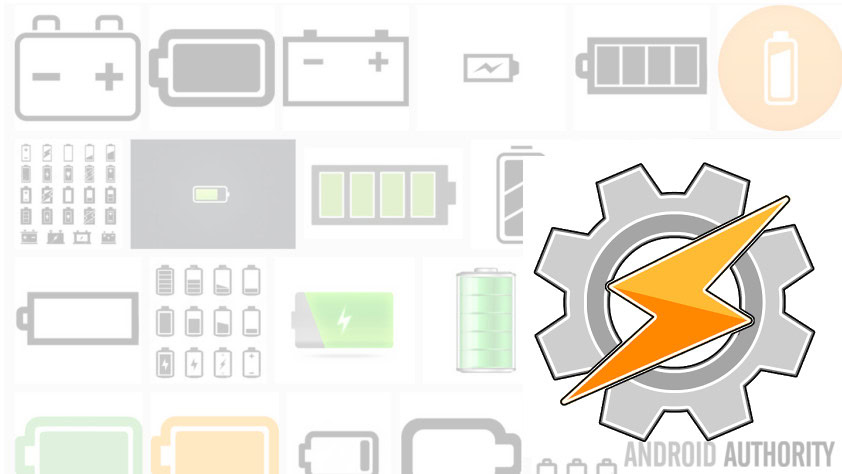
Let’s walk through the approach to this project with a bit more detail. Unless you have a brand new device, I am sure you have an idea of just how long your battery typically lasts on your Android phone or tablet. You might be used to an average of about 3-4 hours of screen-on time for a phone, 4-5 hours for a tablet, but no matter what it is, you’ll need to take note of that number before anything else.
The project is actually really simple, as an overview, if you expect your battery to last a minimum of 5 hours, but it is draining at a rate that would kill it in, say, 4 hours, we simply throw up a warning, alarm, notification or something of that sort. There are a few ways this can be done, for today, we’ll do it by tracking the amount of time in between each 1% drain in your battery.
Some math to get started
As mentioned, you need to have an idea of what amount of time your battery should last, for this, go with the amount of time it will last with the display turned on. I’ll build my project based on 3 hours of screen-on time.
What we need to proceed is to figure out how many seconds each 1% of your battery should last. Luckily, there are 100 percentage points in everyone’s battery, so the math is more about converting time than anything. Our math goes as follows, 3 hours is 180 minutes, which is 10,800 seconds. Divide that by my 100 percentage points and we get that each 1% of my battery should last at least 108 seconds.
Is that easy enough to understand? All we will be doing is watching the time between battery level changes, if it drops 1% in less than 108 seconds, the battery is draining too fast for our liking. And if it lasts for more than 108 seconds, all is well. No warnings required.
Let me give you a few numbers, save you some work: 3 hours screen-on is worth 108 seconds. 2.5 hours is worth 90 seconds. 3.5 hours is worth 126 seconds. 4 hours is worth 144 seconds. 4.5 hours is worth 162 seconds. And 5 hours is worth 180 seconds. Any other values and you’ll have to do the math for yourself, sorry.
The project
Once you dive into Tasker, the specifics of your project, in order, will be to build a Task that collects the current time, compares it to a Variable containing a previously saved time, if the difference is too short, it throws up an Alert, and then it re-writes the placeholder time Variable for use the next time this Task runs. With the Task complete, you then build a Profile that runs every time the battery level changes. Nice and easy.
Time comparison Task
We start off by building our Task, which will be the major piece of this project. As always, this could be built out into a few different re-usable Tasks, but we’ll do it all at once for today.
Head to the Task section and hit the “+” button to begin a new Task. Name it appropriately, I’ll call mine “BatteryDrainWarning“.
Now, we must start at the end, with our Variable, to prevent errors when we start doing the heavy lifting.
Tap the “+” button to start the action.
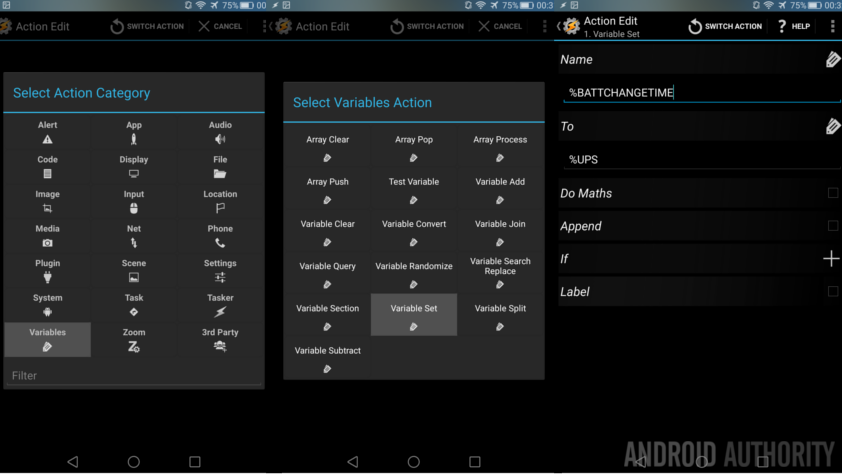
Choose Variables.
Choose Variable Set.
Provide a name for your new variable. Remember that you need to start with the % symbol and we want this variable to go global, so use all capital letters. I’ll call mine “%BATTCHANGETIME“.
Now, in the To section, tap the little label icon to search the built-in variables, choose Uptime Seconds. Or, you can just type “%UPS” onto the To line.
Tap the system Back button to save and exit out of the action.
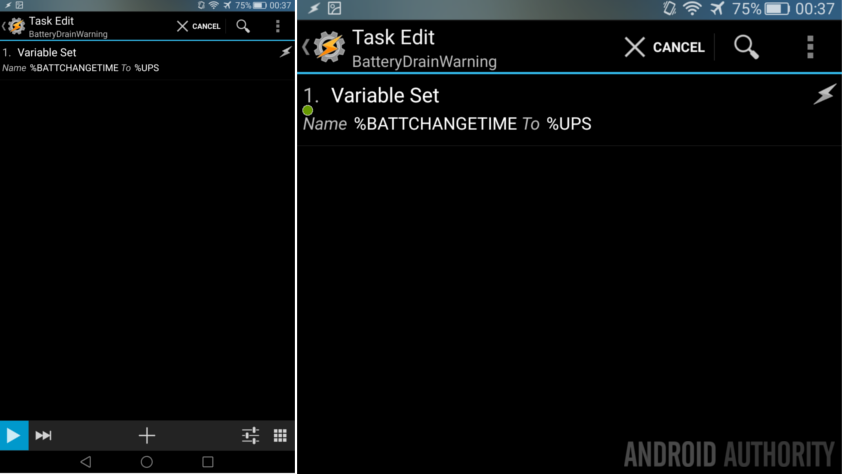
Now, this is important, you need to run this Task before we continue. Just tap that triangle play icon in the bottom left, watch for the green dot beside the Variable action to confirm completion.
Now we can proceed to the big actions. Tap that “+” button to start your next action.
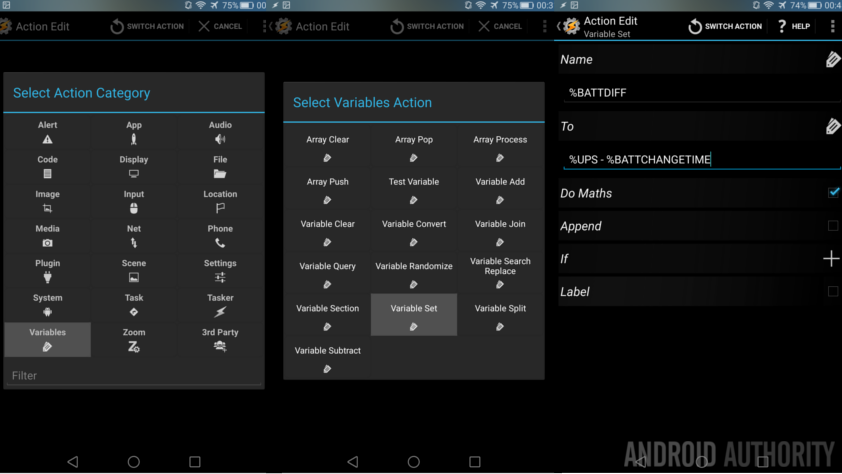
Once again, select Variables and then Variable Set.
Name your next variable something like “%BATTDIFF“.
Then, in the To section, enter a mathematical equation to calculate the time in between battery changes, since we are using UpTime, we simply subtract our saved UpTime in the previous Variable from the current UpTime. Or, just enter the following:
%UPS – %BATTCHANGETIME
Now, turn on the check box beside Do Maths.
Hit that system Back button and let’s take some action.
Tap the “+” button to add your next action.
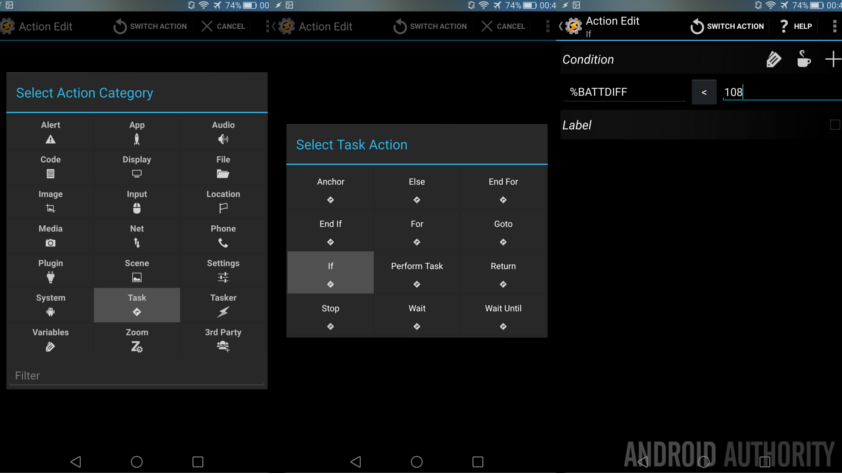
Choose Task.
Choose If.
In the Condition fields, first enter your battery difference variable, mine was “%BATTDIFF“.
Tap the “~” button to change the comparison to Maths: Less Than, which will enter the “<” symbol.
Then enter into the Value field your number of seconds you want your device to last between battery drain, if you recall from earlier, mine is 108.
Tap the system Back button to get back to the actions list.
With that IF in place, we are saying simply, if the difference in time between now and the last time our battery changed levels is less than 108 seconds, let’s do something. What shall we do? Let’s keep this simple, I’d like for now to just flash a message on the screen.
Tap the “+” button.
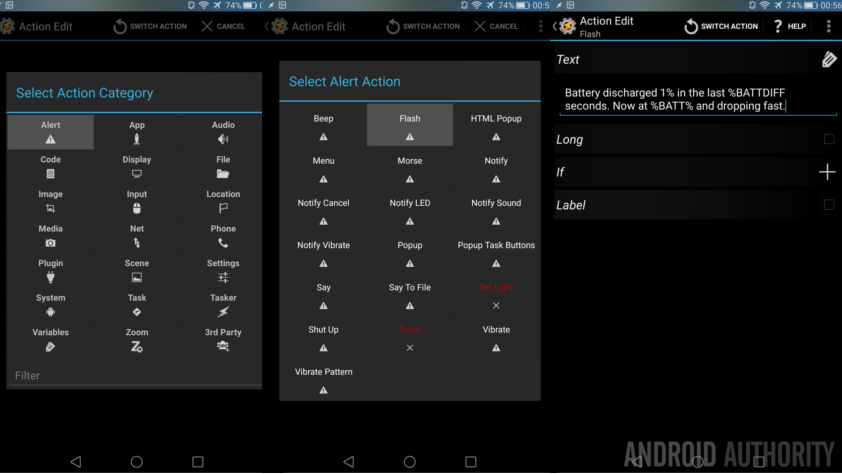
Choose Alert.
Choose Flash.
In the Text field, write yourself a message, remember to include the variables to add extra value. You might put something like:
“Battery discharged 1% in the last %BATTDIFF seconds. Now at %BATT% and dropping fast.” Or you might just put “Battery drain warning” if you don’t want to see the details on the screen.
Tap the system Back button to get back tot he actions list.
Now, as all good programmers will tell you, we must close the IF statement with an END IF.
Tap that “+” button.
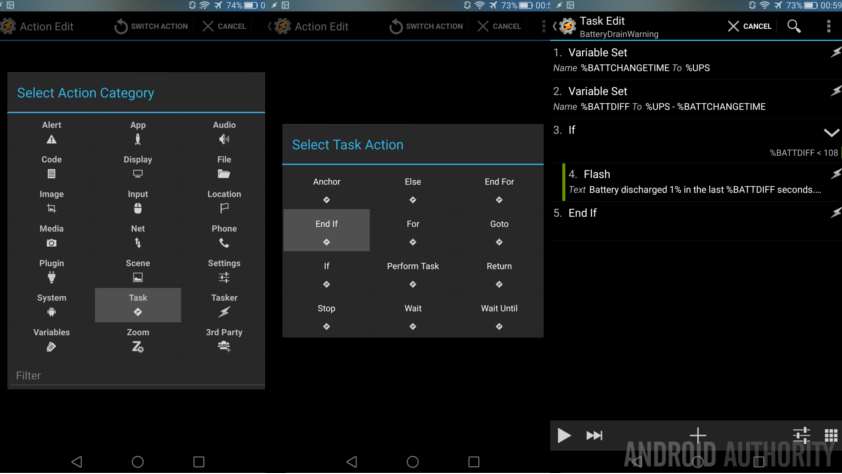
Select Task.
Select End If. Nice and easy.
Now, before you do anything else, we have to clean up that first action we created, remember that it is supposed to be the last things we do here, not the first.
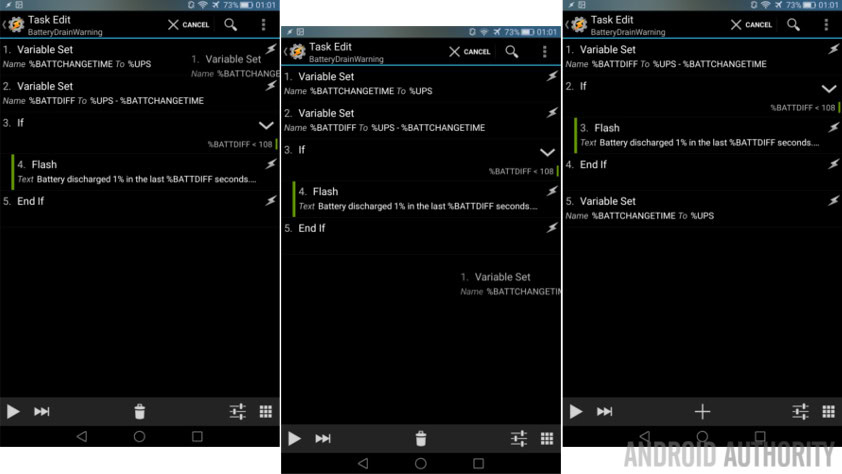
Long press on the right hand edge of the action, then drag to the bottom.
im
There we go, we now have a Task that looks at the time your battery last changed, figures out how long ago that was, then if, and only if, that amount of time is too short for our liking, we throw a warning message onto the screen. Then, at the end, we re-set the variable that remembers the last time the battery level changed, all ready to go for next time.
Remember to hit that system Back button to exit out of the Task creation. What we need now is to create the Profile that makes this all take action.
Profile to run the battery warning Task
Now that you have the Task filled out with calculations and actions all completed, let’s create the Profile that triggers it.
Head over to Profiles and hit that “+” button to get started. Provide a name, if asked, I called mine “BatteryDischarge“.
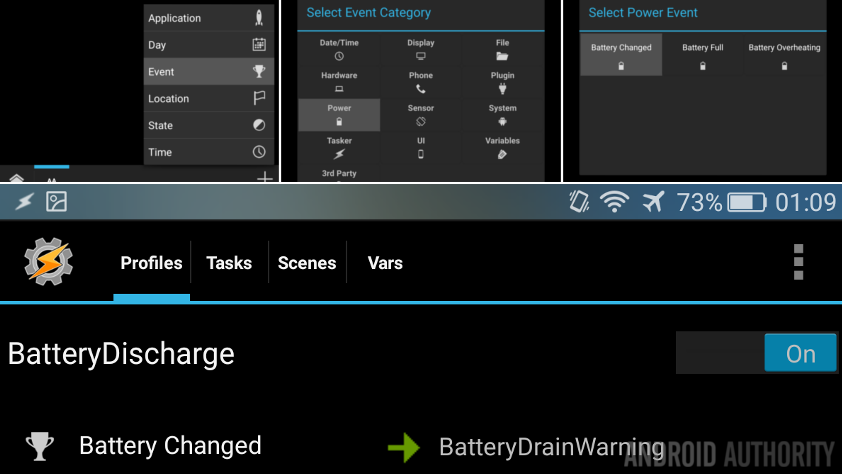
Choose Event.
Choose Power.
Choose Battery Changed.
Change priority if you so desire, otherwise just hit the system Back button to continue.
Now choose your “BatteryDrainWarning” Task.
One last thing before we call this complete, I am sure you do not want to see the warning pop up when you are charging the device. Right now it will, so let’s add a condition so that the Task only fires off when your device is not plugged in.
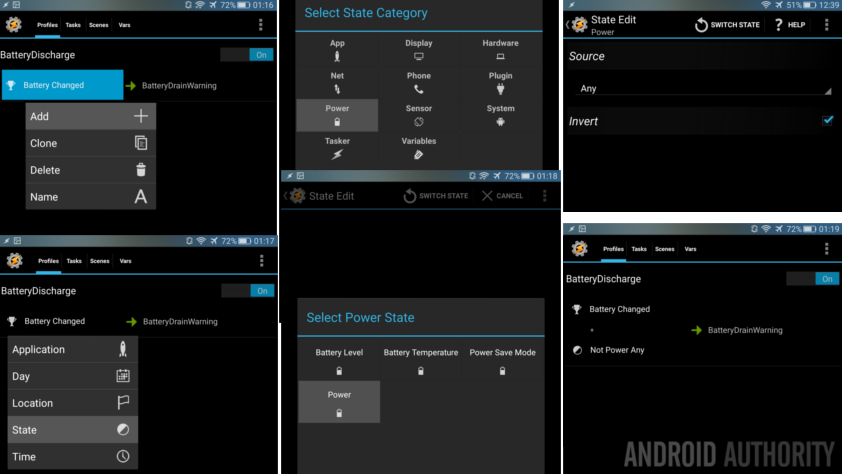
Long press on the words Battery Changed.
Choose Add.
Choose State.
Choose Power.
Choose Power. (Again.)
Leave it on Any and turn on the check mark beside Invert.
Hit that system Back button to see your new completed Profile.
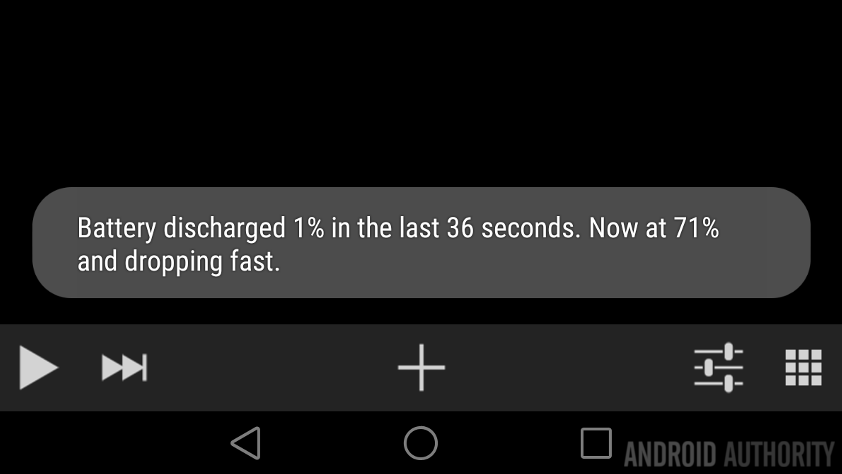
Sit back and enjoy. Or, I suppose this is not something to enjoy, being that when you see this project in action, your battery is dying quickly. But hey, you know what I mean.
Remember that you can go back to that IF statement and change up your time to get different results. If you increase the number, you will see more warnings, if you decrease the number, you will see fewer warnings. If you just want to test to make sure this thing is working, temporarily change that 108 to like 10800, then you are sure to see the message every time the battery level drops.
What’s next
I found that my warning message was too long, most times I wasn’t able to read it all before it disappeared from the screen. That said, I didn’t want to remove any of the information, so I needed to do something, and making it appear on screen longer was not desirable. What do you know, we created a project just last week that takes information like this and writes it to a text file. Now I have a BatteryWarningsLog.txt file saved on my device that I can jump back to if I miss the actual warnings.
We worked off of a single battery life expectancy for the project today, but we all know that battery life is different when the display is turned on vs when it is off. No worries, you can handle this too. I’ll leave the work to you, but, basically, you can completely duplicate today’s project with the longer time value (screen-off should last you 24+ hours, right? Or more than 864 seconds.) When creating the profile, add an extra condition, Display->Display State Off and add the opposite Display State On for the first profile created today.
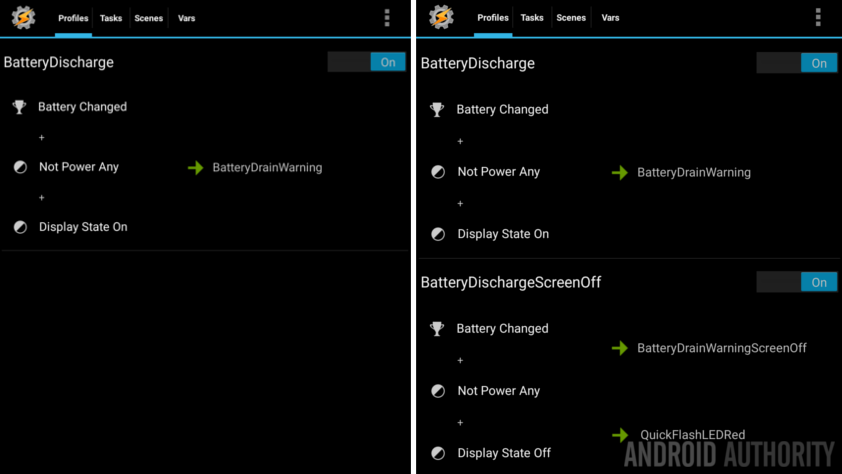
If flashing a message to the display is not appropriate or enough for you, as it wouldn’t be with the display turned off, consider using different notification tools. For example, I’ve gone ahead and used the Notify LED action. Just flash the red light a few times, then turn it off. No point having a lingering notification and flashing lights to kill the battery even faster.
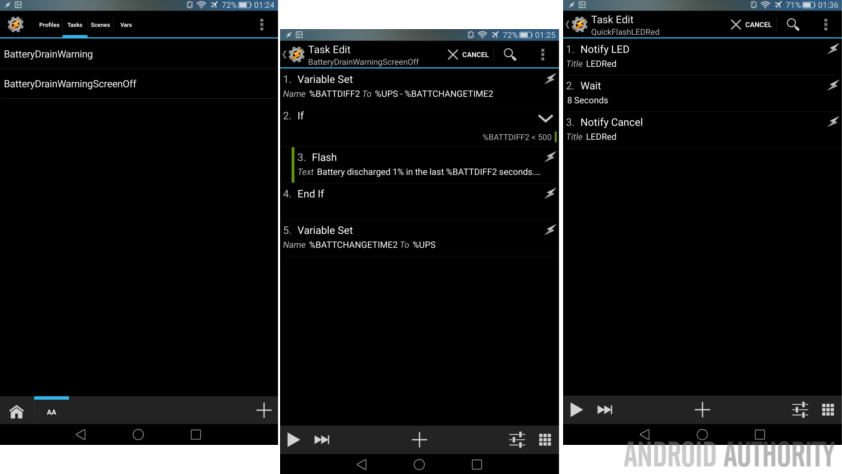
But wait, there’s more. I just wanted to explain one last thing that I’ve done for my project, I wanted more info, so I created another variable that figures out how much longer my battery will last at its current level and rate of discharge. I simply added that into my on-screen popup message. Oh, and don’t forget that you can use tools like Pushbullet to receive these warnings remotely to your PC or other devices.
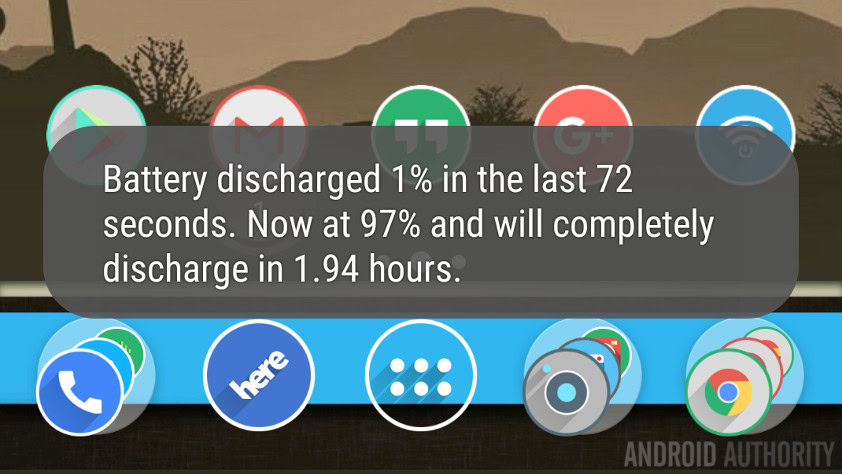
A couple things to be aware of: because we are utilizing the device up-time for our calculations, the very first battery change after a reboot may provide a false positive warning. You may also see hiccups when you first unplug from charging your device. You can overcome these by adding full Tasker projects to change that BATTCHANGETIME variable when the device is powered on or when removed from charger. I can live with these two minor and predictable false positives, myself.
Finally, all we have done today is identify when your battery is discharging quickly. If you need to figure out what is killing your battery, be sure to jump back to some of our previous posts on the subject.
Next week
I hope this Android customization project was as much fun for you as it was for me. Perhaps it is a little frivolous to track real-time battery consumption, and maybe just a bit rough on the battery itself, but I certainly learned how to use old functions in new ways on this project. Next week will be more of this concept, we won’t be looking at your battery again, instead, we are planning to put together an automated time card, for you to track your time spent doing, well, whatever it is you do.
I have to admit that I only just thought up this project a week ago, do any of you have similar projects, or advice you’d care to share?